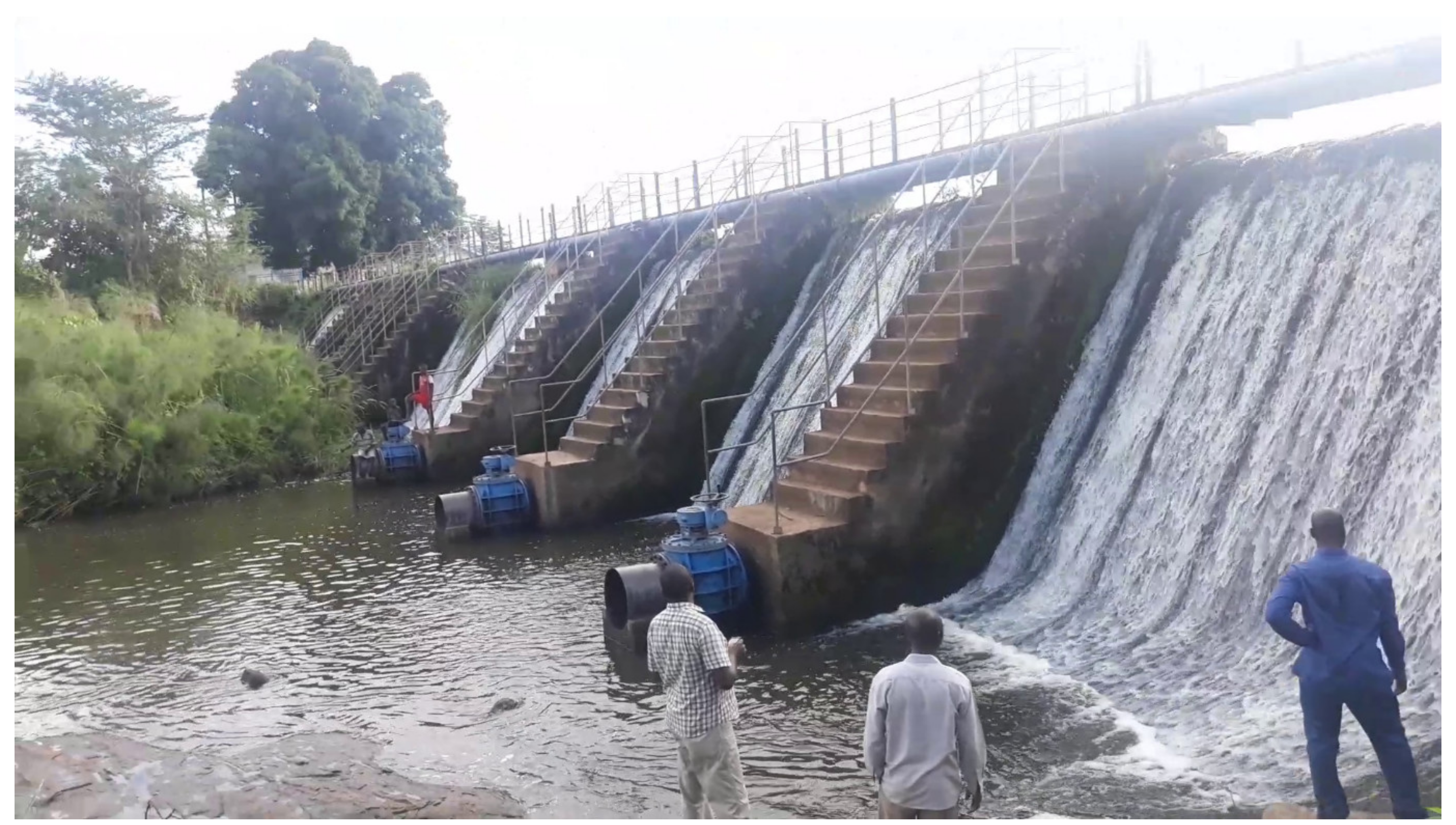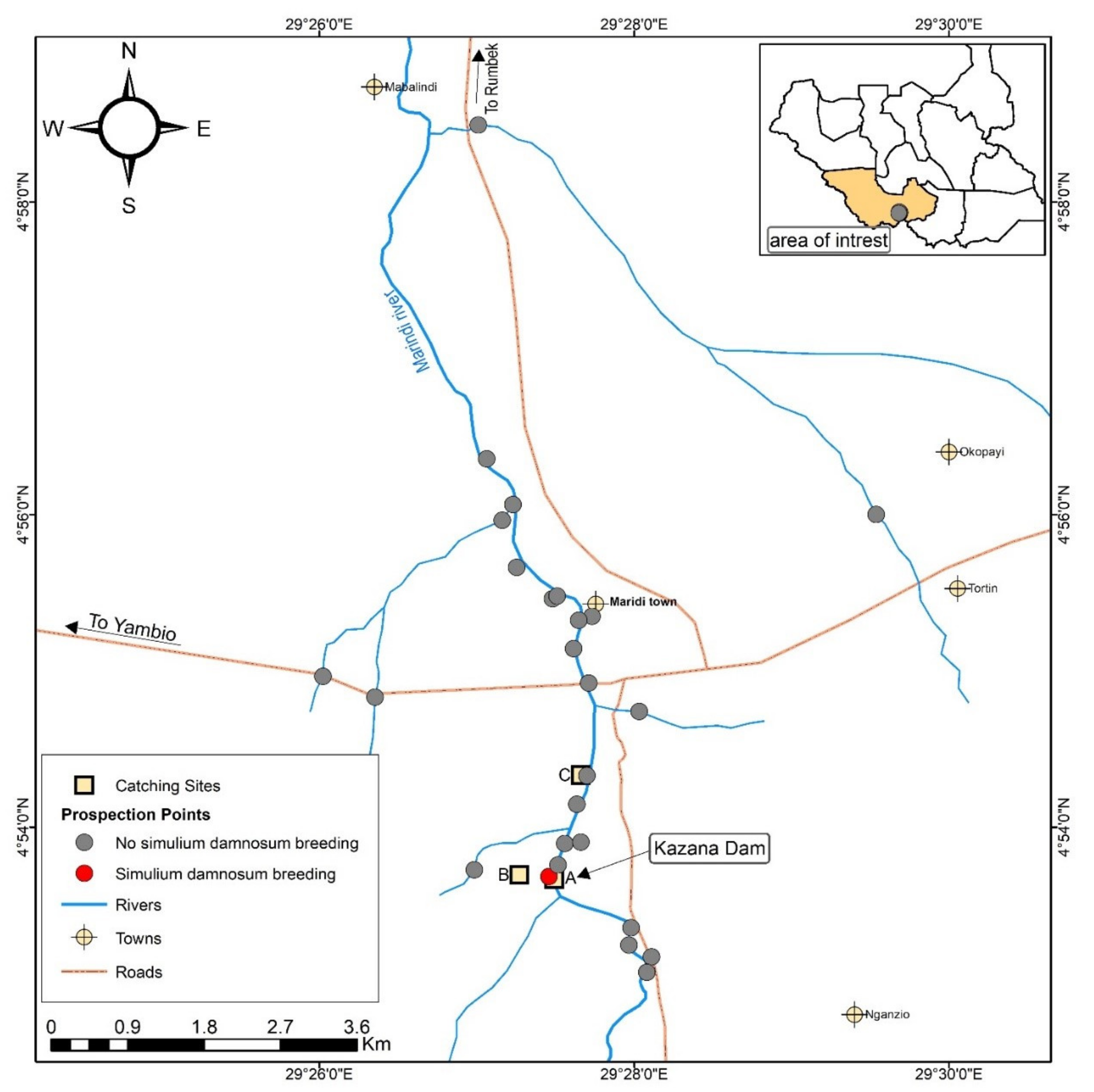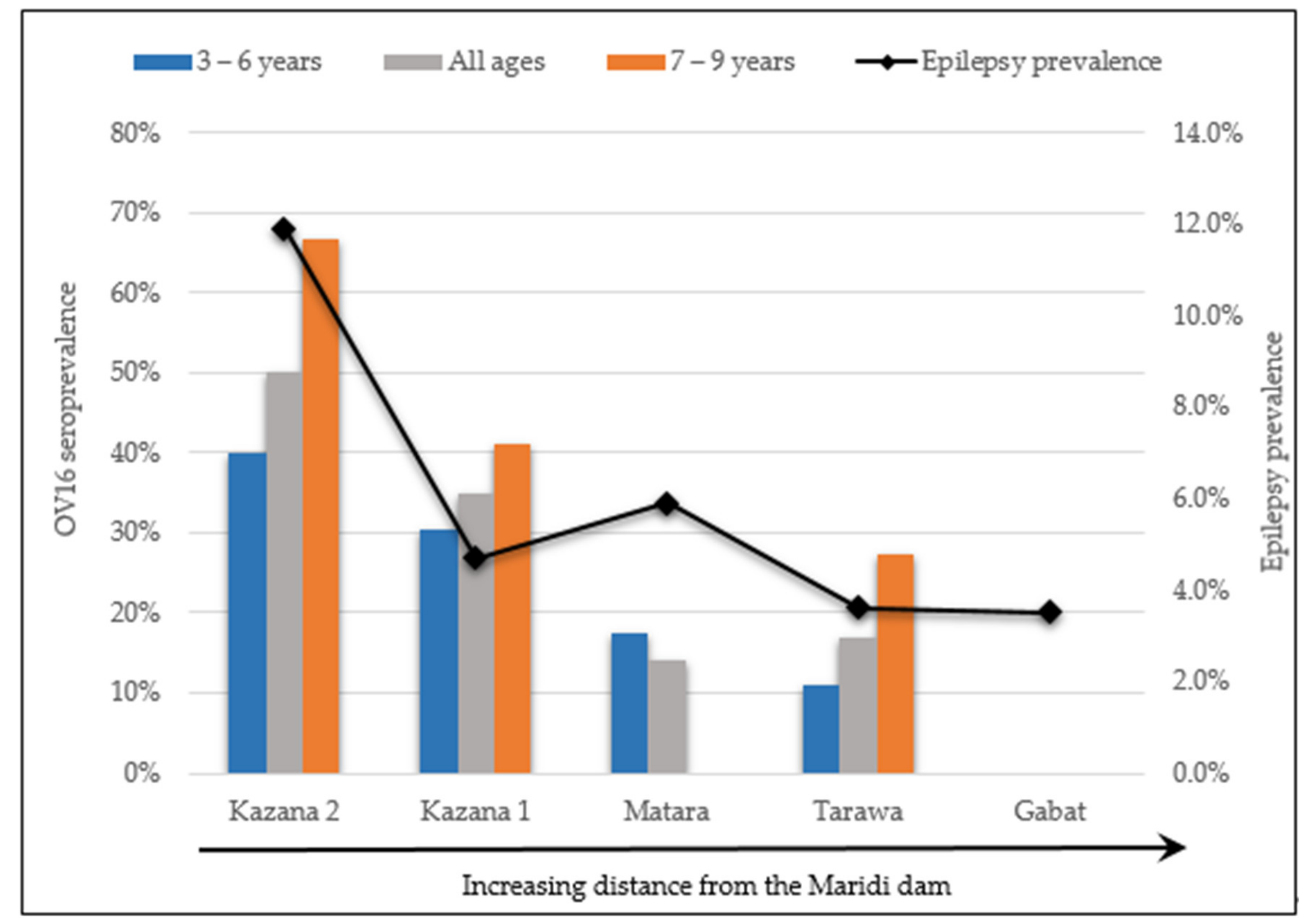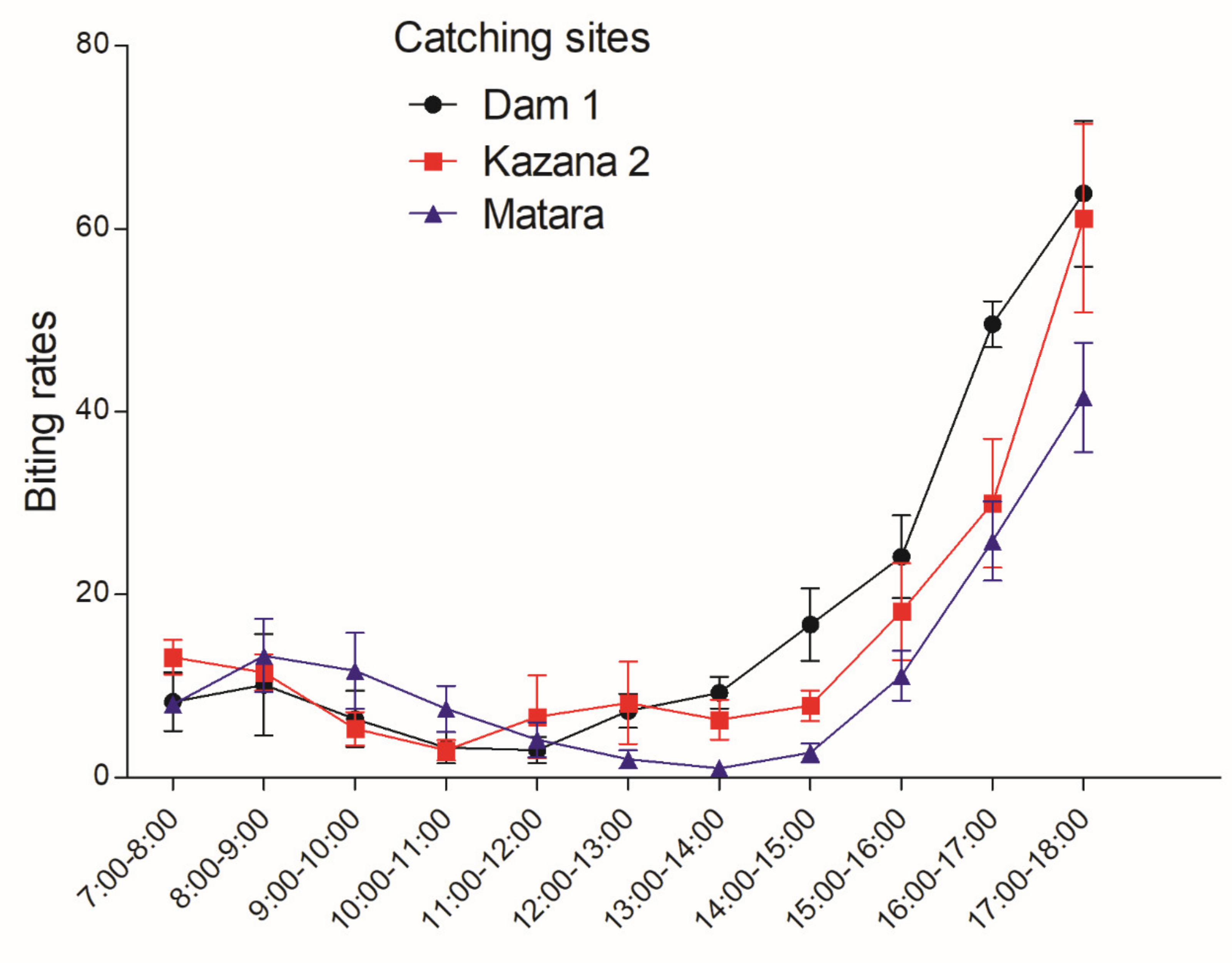The Role of the Maridi Dam in Causing an Onchocerciasis-Associated Epilepsy Epidemic in Maridi, South Sudan: An Epidemiological, Sociological, and Entomological Study
Abstract
1. Introduction
2. Materials and Methods
2.1. Description of the Study Area
2.2. Focus Group Discussions and in Depth Interviews
2.3. OV16 Testing
2.4. Entomological Study
2.4.1. Search for Breeding Sites on the Maridi River
2.4.2. Establishment of Catching Sites along the Maridi River
2.4.3. Human Landing Catches (HLC) of Adult Biting Simulium along the Maridi River
2.4.4. Dissection of Flies for Age Group Determination (Parity)
2.5. Data Analysis
2.6. Ethical Considerations
3. Results
3.1. Focus Group Discussions (FGD)
3.2. OV16 Testing
3.3. Entomological Investigations
3.3.1. Search for Breeding Sites on the Maridi River
- The Maridi River is perennial and originates from the border of the Republic of South Sudan with the Democratic Republic of the Congo (DRC). The river is predominantly covered with papyrus swamp with only a few sites with open water. Downstream the Maridi River is joined by the Mbalala River on the Maridi−Yei road (N: 4°53′10.2″; E: 29°28′6.6″) which is equally dominated by an extensive papyrus swamp with sluggish water flow. This river is the main source of water for Maridi town. The dam has a spillway measuring 132 m across where the water flows down a constructed concrete face falling some 6 m to join the river flowing northwards. This spillway with an estimated water discharge of about 0.4 m3/sec was overgrown with vegetation, and numerous larvae and pupae were found attached to the vegetation. In some areas of the spillway some pupae were collected attached to the concrete surface.
- The second site on the Maridi River was located some 4.5 km downstream from the Maridi dam and 1 km southwest of Maridi State Hospital. This site at Temeregia foot-crossing (N: 4°55′8.5″; E: 29°27′36.9″) was the only site observed to be open with fast flowing water. At this site water flows over rocks covered with a carpet of algae, making it unsuitable for S. damnosum breeding. The remaining 24 of the 26 sites visited were all characterized by extensive swamps with poor water flow.
3.3.2. Human Landing Catches of Adult Biting Simulium along the Maridi River
3.3.3. Dissection of Flies for Age Group Determination (Parity)
4. Discussion
5. Conclusions
Supplementary Materials
Author Contributions
Funding
Acknowledgments
Conflicts of Interest
References
- Burnham, G. Onchocerciasis. Lancet 1998, 351, 1341–1346. [Google Scholar] [CrossRef]
- Colebunders, R.; Hendy, A.; van Oijen, M. Nodding Syndrome in Onchocerciasis Endemic Areas. Trends Parasitol 2016, 32, 581–583. [Google Scholar] [CrossRef]
- Progress towards eliminating onchocerciasis in the WHO Region of the Americas: Verification of elimination of transmission in Guatemala. Wkly. Epidemiol. Rec. 2016, 91, 501–505.
- Dadzie, Y.; Amazigo, U.V.; Boatin, B.A.; Seketeli, A. Is onchocerciasis elimination in Africa feasible by 2025: A perspective based on lessons learnt from the African control programmes. Infect. Dis. Poverty 2018, 7, 63. [Google Scholar] [CrossRef]
- Cupp, E. Elimination of onchocerciasis in Africa by 2025: The need for a broad perspective. Infect. Dis. Poverty 2019, 8, 50. [Google Scholar] [CrossRef]
- Colebunders, R.; Basanez, M.G.; Siling, K.; Post, R.J.; Rotsaert, A.; Mmbando, B.; Suykerbuyk, P.; Hopkins, A. From river blindness control to elimination: Bridge over troubled water. Infect. Dis. Poverty 2018, 7, 21. [Google Scholar] [CrossRef]
- Katabarwa, M.N.; Lakwo, T.; Habomugisha, P.; Unnasch, T.R.; Garms, R.; Hudson-Davis, L.; Byamukama, E.; Khainza, A.; Ngorok, J.; Tukahebwa, E.; et al. After 70 years of fighting an age-old scourge, onchocerciasis in Uganda, the end is in sight. Int. Health 2018, 10, i79–i88. [Google Scholar] [CrossRef]
- Colebunders, R.; Carter, J.Y.; Olore, P.C.; Puok, K.; Bhattacharyya, S.; Menon, S.; Abd-Elfarag, G.; Ojok, M.; Ensoy-Musoro, C.; Lako, R.; et al. High prevalence of onchocerciasis-associated epilepsy in villages in Maridi County, Republic of South Sudan: A community-based survey. Seizure 2018, 63, 93–101. [Google Scholar] [CrossRef]
- Colebunders, R.; Abd-Elfarag, G.; Carter, J.Y.; Olore, P.C.; Puok, K.; Menon, S.; Fodjo Siewe, J.N.; Bhattacharyya, S.; Ojok, M.; Lako, R.; et al. Clinical characteristics of onchocerciasis-associated epilepsy in villages in Maridi County, Republic of South Sudan. Seizure 2018, 62, 108–115. [Google Scholar] [CrossRef]
- National bureau of Statistics. Population Distribution by Age Group by Sex by Payam by Release M.2; National Bureau Edited of Statistics: Juba, South Sudan, 2013; Available online: http://www.ssnbss.org/home/document/census/population-distribution-by-age-group-sex-and-payam-greater-bahr-el-ghazal (accessed on 24 April 2020).
- Hocking, B.; Hocking, J.M. Entomological aspects of African onchocerciasis and observations on Simulium in the Sudan. Bull. World Health Organ. 1962, 27, 465–472. [Google Scholar]
- Colebunders, R.; Hendy, A.; Mokili, J.L.; Wamala, J.F.; Kaducu, J.; Kur, L.; Tepage, F.; Mandro, M.; Mucinya, G.; Mambandu, G.; et al. Nodding syndrome and epilepsy in onchocerciasis endemic regions: Comparing preliminary observations from South Sudan and the Democratic Republic of the Congo with data from Uganda. BMC Res. Notes 2016, 9, 182. [Google Scholar] [CrossRef] [PubMed]
- Davies, J.B. Observations on Simulium damnosum s. 1 in the Thyolo Highlands of Malawi; World Health Organization: Genewa, Switzerland, 1985. [Google Scholar]
- Garms, R.; Lakwo, T.L.; Ndyomugyenyi, R.; Kipp, W.; Rubaale, T.; Tukesiga, E.; Katamanywa, J.; Post, R.J.; Amazigo, U.V. The elimination of the vector Simulium neavei from the Itwara onchocerciasis focus in Uganda by ground larviciding. Acta Trop. 2009, 111, 203–210. [Google Scholar] [CrossRef] [PubMed]
- World Health Organization. Onchocerciasis and its control. Report of a WHO Expert Committee on Onchocerciasis Control. Tech. Rep. Series 1995, 852, 103. [Google Scholar]
- Renz, A.; Wenk, P. Studies on the dynamics of transmission of onchocerciasis in a Sudan-savanna area of North Cameroon I. Prevailing Simulium vectors, their biting rates and age-composition at different distances from their breeding sites. Ann. Trop. Med. Parasitol. 1987, 81, 215–228. [Google Scholar] [CrossRef]
- Lewis, D.J. Observations on Simulium damnosum in the Southern Cameroons and Liberia. Ann. Trop. Med. Parasitol. 1960, 54, 208–223. [Google Scholar] [CrossRef]
- Walsh, J.F.; Davies, J.B.; Le Berre, R. Entomological aspects of the first five years of the Onchocerciasis Control Programme in the Volta River Basin. Tropenmed Parasitol. 1979, 30, 328–344. [Google Scholar]
- Walsh, J.F.; Garms, R.; Lakwo, T. Planning of Focal Vector Eradication in Onchocerciasis Foci in Uganda; Report to UNDP/World Bank/; WHO: Kampala, Uganda, 1996. [Google Scholar]
- Prentice, M.A. Simulium Control Program in Uganda. In Research and Control of Onchocerciasis in the Western Hemisphere; Science Publication No. 298; Pan American Health Organization: Washington, DC, USA, 1974; pp. 87–93. [Google Scholar]
- Zarroug, I.M.; Hashim, K.; Elaagip, A.H.; Samy, A.M.; Frah, E.A.; ElMubarak, W.A.; Mohamed, H.A.; Deran, T.C.; Aziz, N.; Higazi, T.B. Seasonal Variation in Biting Rates of Simulium damnosum sensu lato, Vector of Onchocerca volvulus, in Two Sudanese Foci. PLoS ONE 2016, 11, e0150309. [Google Scholar] [CrossRef]
- Colebunders, R.; Nelson Siewe, F.J.; Hotterbeekx, A. Onchocerciasis-Associated Epilepsy, an Additional Reason for Strengthening Onchocerciasis Elimination Programs. Trends Parasitol. 2018, 34, 208–216. [Google Scholar] [CrossRef]
- JN, S.F.; Remme, J.H.; Preux, P.M.; Colebunders, R. Meta-analysis of epilepsy prevalence in West Africa and its relationship with onchocerciasis endemicity and control. Int. Health 2020, ihaa012. [Google Scholar] [CrossRef]
- Lewis, D.J. Simulium damnosum and its relation to onchocerciasis in the Anglo-Egyptian Sudan. Bull. Entomol. Res. 1953, 43, 597–644. [Google Scholar] [CrossRef]
- Wahl, G.; Enyong, P.; Ngosso, A.; Schibel, J.M.; Moyou, R.; Tubbesing, H.; Ekale, D.; Renz, A. Onchocerca ochengi: Epidemiological evidence of cross-protection against Onchocerca volvulus in man. Parasitology 1998, 116, 349–362. [Google Scholar] [CrossRef] [PubMed]
- Gumisiriza, N.; Mubiru, F.; Siewe Fodjo, J.N.; Mbonye Kayitale, M.; Hotterbeekx, A.; Idro, R.; Makumbi, I.; Lakwo, T.; Opar, B.; Kaducu, J.; et al. Prevalence and incidence of nodding syndrome and other forms of epilepsy in onchocerciasis-endemic areas in northern Uganda after the implementation of onchocerciasis control measures. Infect. Dis. Poverty 2020, 9, 12. [Google Scholar] [CrossRef]
- Burton, G.J.; McRae, T.M. Dam-spillway breeding of Simulium damnosum Theobald in northern Ghana. Ann. Trop. Med. Parasitol. 1965, 59, 405–412. [Google Scholar] [CrossRef] [PubMed]
- Adewale, B.; Mafe, M.A.; Oyerinde, J.P. Infectivity and transmission dynamics of simulium damnosum s. 1 around Owena dam (Ondo State). West. Afr. J. Med. 1999, 18, 257–260. [Google Scholar]
- Kuzoe, F.A.; Hagan, K.B. The control of Simulium damnosum Theobald (Diptera, Simuliidae) in the region of the Volta Dam. Ann. Trop. Med. Parasitol. 1967, 61, 338–348. [Google Scholar] [CrossRef]
- Burton, P. L’onchocercose humaine en Afrique de l’Ouest: Vecteurs, agents pathogènes, épidémilogie, lutte. Paris Ostrom 1978, 37, 197. [Google Scholar]
- Parent, G.; Ouédraogo, A.; Zagré, N.M.; Compaoré, I.; Kambiré, R.; Poda, J.N. Large dams, health and nutrition in Africa: Beyond the controversy. Santé 1997, 7, 417–422. [Google Scholar]
- Mahoney. Onchocerciasis in expatriates on the Ivory Coast. South. Med. J. 1981, 74, 295–297. [Google Scholar]
- Zarroug, I.M.; Elaagip, A.H.; Abuelmaali, S.A.; Mohamed, H.A.; ElMubarak, W.A.; Hashim, K.; Deran, T.C.; Aziz, N.; Higazi, T.B. The impact of Merowe Dam on Simulium hamedense vector of onchocerciasis in Abu Hamed focus—Northern Sudan. Parasit Vectors 2014, 7, 168. [Google Scholar] [CrossRef]
- Ba-Diop, A.; Marin, B.; Druet-Cabanac, M.; Ngoungou, E.B.; Newton, C.R.; Preux, P.-M. Epidemiology, causes, and treatment of epilepsy in sub-Saharan Africa. Lancet Neurol. 2014, 13, 1029–1044. [Google Scholar] [CrossRef]
- Jacob, B.G.; Loum, D.; Lakwo, T.L.; Katholi, C.R.; Habomugisha, P.; Byamukama, E.; Tukahebwa, E.; Cupp, E.W.; Unnasch, T.R. Community-directed vector control to supplement mass drug distribution for onchocerciasis elimination in the Madi mid-North focus of Northern Uganda. PLoS Negl. Trop. Dis. 2018, 12, e0006702. [Google Scholar] [CrossRef] [PubMed]
- Abd-Elfarag, G.; Logora, M.Y.; Carter, J.Y.; Ojok, M.; Songok, J.; Menon, S.; Wit, F.; Lako, R.; Colebunders, R. The effect of bi-annual community-directed treatment with ivermectin on the incidence of epilepsy in onchocerciasis endemic villages in South Sudan: A study protocol. Infect. Dis. Poverty 2018, 7, 112. [Google Scholar] [CrossRef] [PubMed]




| OV16 Seroprevalence | Comparisons | ||||||
|---|---|---|---|---|---|---|---|
| Gabat | Kazana 1 | Kazana 2 | Matara | Tarawa | Overall | p-Value * | |
| Age-groups | |||||||
| 3–6 years | 0/17 (0%) | 7/23 (30.4%) | 6/15 (40.0%) | 4/23 (17.4%) | 2/18 (11.1%) | 19/96 (19.8%) | 0.074 |
| 7–9 years | 0/7 (0%) | 7/17 (41.2%) | 6/9 (66.7%) | 0/4 (0%) | 3/11 (27.3%) | 16/48 (33.3%) | |
| Gender | |||||||
| Male | 0/14 (0%) | 10/26 (38.5%) | 4/10 (40.0%) | 3/11 (27.3%) | 2/13 (15.4%) | 19/74 (25.7%) | 0.694 |
| Female | 0/10 (0%) | 4/14 (28.6%) | 8/14 (57.1%) | 1/16 (6.3%) | 3/16 (18.8%) | 16/70 (22.9%) | |
| No | Catching Site | Dates for Catches in November−December 2019 | Total | Mean DBR | ||||||
|---|---|---|---|---|---|---|---|---|---|---|
| 29/11 | 30/11 | 2/12 | 3/12 | 4/12 | 5/12 | 6/12 | 7 days | |||
| 1 | Maridi dam | 228 | 147 | 271 | 219 | 143 | 176 | 230 | 1414 | 202.0 |
| 2 | Kazana 2 | 162 | 120 | 84 | 207 | 196 | 193 | 183 | 1145 | 163.6 |
| 3 | Matara | 100 | 72 | 157 | 118 | 93 | 145 | 169 | 854 | 122.0 |
| Catching Site | No. of Flies Caught | No. Dissected | No. Parous | Parity Rate (%) |
|---|---|---|---|---|
| Maridi dam | 143 | 140 | 19 | 13.1 |
| Kazana 2 | 147 | 145 | 15 | 10.7 |
| Matara | 118 | 115 | 18 | 15.7 |
| Total | 408 | 400 | 52 | 13.0 |
© 2020 by the authors. Licensee MDPI, Basel, Switzerland. This article is an open access article distributed under the terms and conditions of the Creative Commons Attribution (CC BY) license (http://creativecommons.org/licenses/by/4.0/).
Share and Cite
Lakwo, T.L.; Raimon, S.; Tionga, M.; Siewe Fodjo, J.N.; Alinda, P.; Sebit, W.J.; Carter, J.Y.; Colebunders, R. The Role of the Maridi Dam in Causing an Onchocerciasis-Associated Epilepsy Epidemic in Maridi, South Sudan: An Epidemiological, Sociological, and Entomological Study. Pathogens 2020, 9, 315. https://doi.org/10.3390/pathogens9040315
Lakwo TL, Raimon S, Tionga M, Siewe Fodjo JN, Alinda P, Sebit WJ, Carter JY, Colebunders R. The Role of the Maridi Dam in Causing an Onchocerciasis-Associated Epilepsy Epidemic in Maridi, South Sudan: An Epidemiological, Sociological, and Entomological Study. Pathogens. 2020; 9(4):315. https://doi.org/10.3390/pathogens9040315
Chicago/Turabian StyleLakwo, T. L., S. Raimon, M. Tionga, J. N. Siewe Fodjo, P. Alinda, W. J. Sebit, J. Y. Carter, and R. Colebunders. 2020. "The Role of the Maridi Dam in Causing an Onchocerciasis-Associated Epilepsy Epidemic in Maridi, South Sudan: An Epidemiological, Sociological, and Entomological Study" Pathogens 9, no. 4: 315. https://doi.org/10.3390/pathogens9040315
APA StyleLakwo, T. L., Raimon, S., Tionga, M., Siewe Fodjo, J. N., Alinda, P., Sebit, W. J., Carter, J. Y., & Colebunders, R. (2020). The Role of the Maridi Dam in Causing an Onchocerciasis-Associated Epilepsy Epidemic in Maridi, South Sudan: An Epidemiological, Sociological, and Entomological Study. Pathogens, 9(4), 315. https://doi.org/10.3390/pathogens9040315






